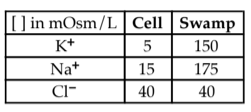For fun, you have used new molecular biology techniques to insert protein channels into the cell membrane that allow only Na+ and Cl- to pass. Predict which ion(s) will move. Tell what direction it (they) will move and what force(s) is/are acting on it (them).
We have finally discovered life on Venus. NASA scientists are investigating a newly discovered life form: a single-celled organism found in the swampy canals. You have been contracted by NASA to perform an electrophysiology study. Using intracellular electrodes to measure the electrical charge inside the cell, you find it has a resting membrane potential of -45 mV when the outside fluid is arbitrarily set to 0 mV. Additionally, you have determined ion concentrations and listed them below.

K+ cannot move because, without potassium channels, the membrane is not permeable to it. Na+ will move into the cell because both its chemical and electrical gradients favor movement in. Cl- leaves the cell due to the electrical gradient (the negative resting potential repels it).
You might also like to view...
A dentist identified the source of the college student's pain while chewing food or gum. Which cranial nerve was inflamed?
A) Trigeminal nerve B) Facial C) Vagus D) Olfactory
Unlike cartilage, bone
A) is a connective tissue. B) has a matrix that contains collagen. C) undergoes remodeling throughout life. D) has an outer covering. E) has cells within lacunae.
________ rearranges the atoms in a molecule
Fill in the blank(s) with the appropriate word(s).
During the ________ period in a muscle cell there is no possibility of generating another action potential
A) relaxation B) contraction C) relative refractory D) absolute refractory